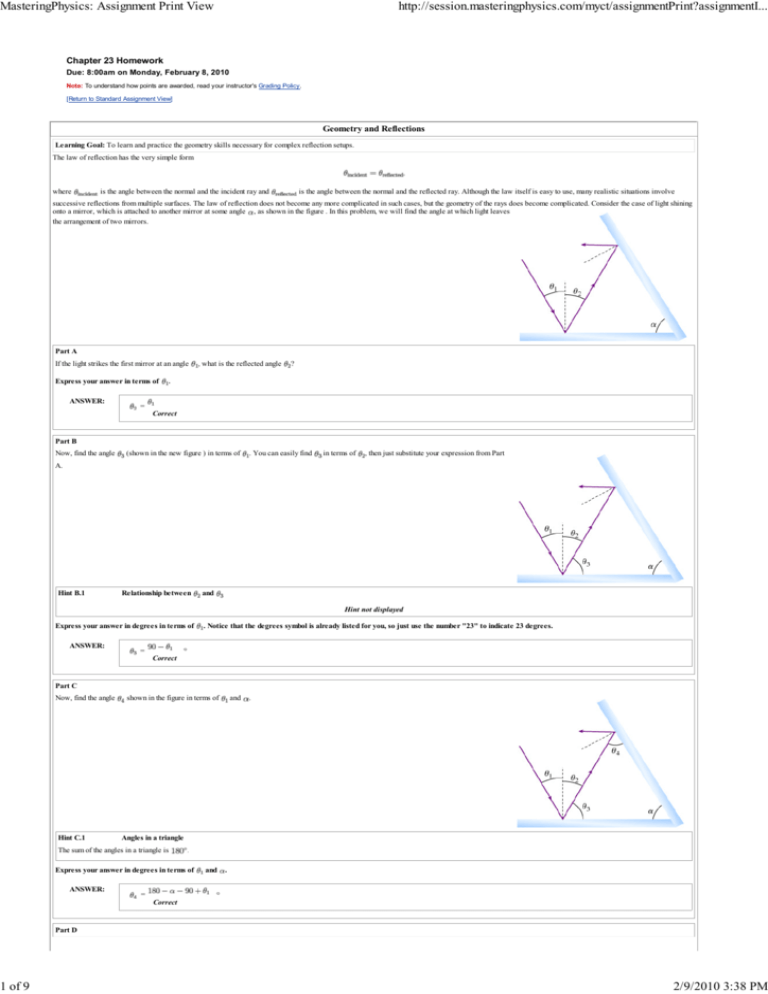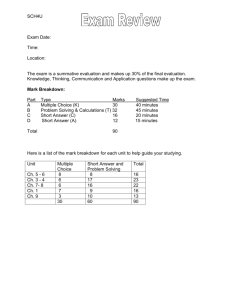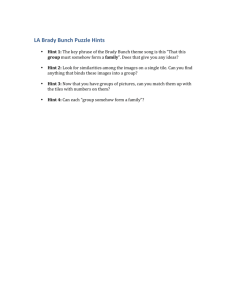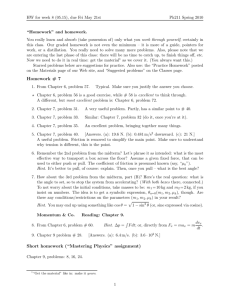MasteringPhysics: Assignmen
advertisement

MasteringPhysics: Assignment Print View 1 of 9 http://session.masteringphysics.com/myct/assignmentPrint?assignmentI... Chapter 23 Homework Due: 8:00am on Monday, February 8, 2010 Note: To understand how points are awarded, read your instructor's Grading Policy. [Return to Standard Assignment View] Geometry and Reflections Learning Goal: To learn and practice the geometry skills necessary for complex reflection setups. The law of reflection has the very simple form , where is the angle between the normal and the incident ray and is the angle between the normal and the reflected ray. Although the law itself is easy to use, many realistic situations involve successive reflections from multiple surfaces. The law of reflection does not become any more complicated in such cases, but the geometry of the rays does become complicated. Consider the case of light shining onto a mirror, which is attached to another mirror at some angle , as shown in the figure . In this problem, we will find the angle at which light leaves the arrangement of two mirrors. Part A If the light strikes the first mirror at an angle Express your answer in terms of ANSWER: , what is the reflected angle ? . = Correct Part B Now, find the angle (shown in the new figure ) in terms of . You can easily find in terms of , then just substitute your expression from Part A. Hint B.1 Relationship between and Hint not displayed Express your answer in degrees in terms of ANSWER: . Notice that the degrees symbol is already listed for you, so just use the number "23" to indicate 23 degrees. = Correct Part C Now, find the angle Hint C.1 shown in the figure in terms of . Angles in a triangle The sum of the angles in a triangle is . Express your answer in degrees in terms of ANSWER: and and . = Correct Part D 2/9/2010 3:38 PM MasteringPhysics: Assignment Print View 2 of 9 Find the angle Hint D.1 shown in the figure in terms of Relationship between http://session.masteringphysics.com/myct/assignmentPrint?assignmentI... and . You will need to assume that , as it appears in the picture. and Hint not displayed Hint D.2 How to find in terms of Hint not displayed Express your answer in degrees in terms of ANSWER: and . = Correct Virtually any reflection problem, no matter how intimidating it may seem, can be broken down into simple parts by considering each individual reflection carefully. Images Produced by Different Concave Mirrors Conceptual Question The same object is placed at different distances in front of six different concave spherical mirrors. Each mirror has the focal length listed below. Part A Which, if any, of these scenarios produce a real image? Which, if any, of these scenarios produce a virtual image? Hint A.1 How to draw a principal ray diagram Hint not displayed Hint A.2 Definition of a real image Hint not displayed Hint A.3 Principal rays for objects within the focal length Hint not displayed Hint A.4 Principal rays for objects outside the focal length Hint not displayed Sort the following scenarios into the appropriate bins. ANSWER: View Correct Part B Which, if any, of these scenarios produce an inverted image? Which, if any, of these scenarios produce an upright image? Sort the following scenarios into the appropriate bins. ANSWER: View Correct Part C Rank the images on the basis of their size. Hint C.1 Ratio of distance to focal length You do not need to know the exact numerical values of the object distance and focal length to determine the magnification of the image. The ratio of the object distance and focal length is sufficient. For example, if the object distance is four times the focal length, the magnitude of the magnification is 1/3, regardless of the exact values of the object distance and focal length. Hint C.2 Object at the focal point If an object is located exactly at the focal point, the image is "infinitely" large. As the object moves away from the focal point, in either direction, the image size decreases. Rank these from largest to smallest. To rank items as equivalent, overlap them. ANSWER: 2/9/2010 3:38 PM MasteringPhysics: Assignment Print View 3 of 9 http://session.masteringphysics.com/myct/assignmentPrint?assignmentI... View Correct Problem 23.38 An object is 15 in front of a concave mirror with a focal length of 23 . Part A Locate the image. Express your answer using two significant figures. ANSWER: = -43 Correct Part B Is the image upright or inverted? ANSWER: The image is upright. The image is inverted. Correct Problem 23.76 A 2.0- -tall object is placed in front of a mirror. A 1.0- -tall upright image is formed behind the mirror, 180 from the object. Part A What is the focal length of the mirror? Express your answer using two significant figures. ANSWER: = -120 Answer Requested Refracted Waves in Unknown Materials Part A When monochromatic light passes through the interface between two unknown materials at an angle where , no changes in the direction of propagation of light are observed. What can be said about the two materials? Hint A.1 How to approach the problem As described by the law of refraction, when light propagates through the interface between two materials with different indexes of refraction, the direction of propagation changes. If no such phenomenon is observed, it means that the two materials have very similar optical properties. Are they necessarily exactly the same material? Check all that apply. ANSWER: The two materials have matching indexes of refraction. The second material through which light propagates has a lower index of refraction. The second material through which light propagates has a higher index of refraction. The two materials are identical. Correct By simply observing no change in the direction of propagation of light at the interface between two materials, you cannot be certain that the two materials are identical. In fact, different materials with matching indexes of refraction would produce a similar effect. For example, at the interface between glass Pyrex ( ) and glycerin ( ), no relevant change in the direction of propagation of light can be observed. Part B The same monochromatic light passes through the interface between two other unknown materials. This time the transmitted wave is observed to be farther from the normal to the interface than the incident wave. What can be said about these two materials and the light traveling through them? Hint B.1 How to approach the problem Hint not displayed Hint B.2 Law of refraction Hint not displayed Hint B.3 Find how the sines of the angles relate Hint not displayed Hint B.4 Find in which material light travels faster Hint not displayed Check all that apply. ANSWER: The second material through which the light propagates has a higher index of refraction. 2/9/2010 3:38 PM MasteringPhysics: Assignment Print View 4 of 9 http://session.masteringphysics.com/myct/assignmentPrint?assignmentI... The second material through which the light propagates has a lower index of refraction. As the light passes into the second material, its speed increases. As the light passes into the second material, its speed decreases. Correct When a ray of light passes into a material having a lower index of refraction, and hence a higher wave speed, the refracted ray bends away from the normal to the interface and will appear closer to the interface than the incident ray. Light Refracted through a Prism Light is incident along the normal to face AB of a glass prism of refractive index 1.55, as shown in the figure. Part A Find , the largest value of the angle Hint A.1 such that no light is refracted out of the prism at face AC if the prism is immersed in air. How to approach the problem Determine the needed angle of incidence on the glass-to-air interface using Snell's law in the regime in which there is total internal reflection. To find the relation between and the angle of incidence as the ray "tries" to move from the glass out into air, copy down the figure and continue the ray across until it actually reaches the interface. You should notice a pair of similar triangles, one containing and one containing the complement of the angle of incidence. You can use these to determine the relation between and the angle of incidence. Hint A.2 Drawing the incident ray and the reflected ray Hint A.3 Snell's law Snell's law states that where is the angle the light ray makes with the normal to the surface as it propagates through a material of index of refraction respect to the normal that the continuing beam makes as it propagates through the material of index of refraction Hint A.4 , and is the angle with . Total internal reflection When a light ray is refracted from a medium of high index of refraction into one of lower index, the refracted ray is bent away from the normal. Moreover, when the angle of refraction reaches 90 degrees, the refracted wave no longer propagates into the medium of lower index of refraction, and total internal reflection occurs. In this case, the angle of incidence has reached a critical value that can be calculated from Snell's law, and all the light is reflected back from the interface into the material of higher index. Express your answer in degrees. Ignore any reflections from the surface BC. ANSWER: = 49.8 Correct Part B Find , the largest value the angle Hint B.1 can have without any light being refracted out of the prism at face AC if the prism is immersed in water (with index of refraction 1.33). How to approach the problem Hint not displayed Express your answer in degrees. Ignore any reflections from the surface BC. ANSWER: = 30.9 Correct Refraction through Glass and Water A plate of glass with parallel faces having a refractive index of 1.58 is resting on the surface of water in a tank. A ray of light coming from above in air makes an angle of incidence 36.5 with the normal to the top surface of the glass. 2/9/2010 3:38 PM MasteringPhysics: Assignment Print View 5 of 9 http://session.masteringphysics.com/myct/assignmentPrint?assignmentI... Part A What angle does the ray refracted into the water make with the normal to the surface? Use 1.33 for the index of refraction of water. Hint A.1 How to approach the problem Hint not displayed Hint A.2 Snell's law Hint not displayed Express your answer in degrees. ANSWER: = 26.6 Correct Note that the index of refraction of the glass doesn't figure at all in finding the angle of refraction in water. The mathematics reduces to: or . The final angle is the same as if the light ray were passing directly from the air into the water. Total Internal Reflection Conceptual Question Consider scenarios A to F in which a ray of light traveling in material 1 is incident onto the interface with material 2. Material 1 ( A ) Material 2 ( air (1.00) water (1.33) B water (1.33) air (1.00) C diamond (2.42) air (1.00) D air (1.00) quartz (1.46) E benzene (1.50) water (1.33) F diamond (2.42) water (1.33) ) Part A For which of these scenarios is total internal reflection possible? Hint A.1 Total internal reflection Hint not displayed Hint A.2 Angle of refraction Hint not displayed Hint A.3 Determine the role of the indices of refraction Hint not displayed List all correct answers in alphabetical order. For example, if scenarios A and E are correct, enter AE. ANSWER: BCEF Correct Part B For the scenarios in which total internal reflection is possible, rank the scenarios on the basis of the critical angle, the angle above which total internal reflection occurs. At this angle, the refracted ray is at 90 from the normal. Hint B.1 Apply Snell's law Hint not displayed Rank from largest to smallest. To rank items as equivalent, overlap them. ANSWER: View 2/9/2010 3:38 PM MasteringPhysics: Assignment Print View 6 of 9 http://session.masteringphysics.com/myct/assignmentPrint?assignmentI... Correct Problem 23.18 A fish in a flat-sided aquarium sees a can of fish food on the counter. To the fish's eye, the can looks to be 30 cm outside the aquarium. Part A What is the actual distance between the can and the aquarium? (You can ignore the thin glass wall of the aquarium.) ANSWER: 22.6 cm Correct The Focal Length of a Lens An object is located 28.0 from a certain lens. The lens forms a real image that is twice as high as the object. Part A What is the focal length of this lens? Hint A.1 How to approach the problem Hint not displayed Hint A.2 Find the magnification Hint not displayed Hint A.3 Find the object distance Hint not displayed Hint A.4 Find the image distance Hint not displayed Hint A.5 Thin-lens equation Hint not displayed ANSWER: 84.0 9.33 10.7 5.36 18.7 Correct Part B Now replace the lens used in Part A with another lens. The new lens is a diverging lens whose focal points are at the same distance from the lens as the focal points of the first lens. If the object is 5.00 what is the height of the image formed by the new lens? The object is still located 28.0 from the lens. Hint B.1 high, How to approach the problem To find the image height you need to know the magnification of the new lens, which can be calculated if you know the image distance and the object distance. To find the image distance you can use the thin-lens equation, but be sure to use the correct value for the focal length. Recall that the focal length of a diverging lens is a negative quantity. Hint B.2 Find the focal length of the new lens Hint not displayed Hint B.3 Find the image distance Hint not displayed Hint B.4 Find the magnification Hint not displayed ANSWER: 12.5 2.0 10.0 11.2 7.5 3.3 Correct Lens Producing an Image Conceptual Question A lens produces a real image of a real object. Part A Is the image inverted or upright? Hint A.1 Orientation Hint not displayed ANSWER: Correct 2/9/2010 3:38 PM MasteringPhysics: Assignment Print View 7 of 9 http://session.masteringphysics.com/myct/assignmentPrint?assignmentI... Part B Is the lens diverging or converging? ANSWER: Correct Part C Is the image enlarged or reduced in size? Hint C.1 Determine the object's location Hint not displayed Hint C.2 Principal rays for possible object location Hint not displayed Hint C.3 Find the change in image size if the object is moved closer Hint not displayed Hint C.4 Find the change in image size if the object is moved farther away Hint not displayed ANSWER: Correct Part D If two convex lenses identical in size and shape are manufactured from glass with two different indices of refraction, would the focal length of the lens with the greater index of refraction (lens 1) be larger or smaller than that of the other lens (lens 2)? Hint D.1 Index of refraction Hint not displayed Hint D.2 Focal length Hint not displayed ANSWER: Correct Part E If lens 1 from Part D were placed in exactly the same location as lens 2, would the image produced by lens 1 be larger or smaller than the image produced by lens 2? Hint E.1 How to approach the problem Hint not displayed Hint E.2 Location of the object Hint not displayed Hint E.3 Image size when object is located at the focal point Hint not displayed Hint E.4 Ratio of distance to focal length Hint not displayed ANSWER: Correct Ray Tracing and Image Formation with a Concave Lens A concave lens refracts parallel rays in such a way that they are bent away from the axis of the lens. For this reason, a concave lens is referred to as a diverging lens. Part A Consider the following diagrams, where F represents the focal point of a concave lens. In these diagrams, the image formed by the lens is obtained using the ray tracing technique. Which diagrams are accurate? Hint A.1 A ray parallel to the lens axis A ray parallel to the axis of a concave lens is refracted along a line that extends back through the focal point on the same side of the lens. Hint A.2 A ray that passes through the focal point A ray that is directed toward the focal point on the other side of the lens is refracted parallel to the lens axis. Hint A.3 A ray that passes through the middle of the lens 2/9/2010 3:38 PM MasteringPhysics: Assignment Print View 8 of 9 http://session.masteringphysics.com/myct/assignmentPrint?assignmentI... A ray that passes through the middle of a concave lens continues on its original direction with essentially no displacement after passing through the lens. Type A if you think that only diagram A is correct, type AB if you think that only diagrams A and B are correct, and so on. ANSWER: AC Answer Requested A concave lens always forms an image that is on the same side of the lens as the object. Part B If the focal length of the concave lens is -7.50 Hint B.1 , at what distance from the lens should an object be placed so that its image is formed 3.70 from the lens? How to approach the problem To determine the object distance you can use the thin-lens equation, but be careful to assign the correct sign to each quantity involved in the equation. Hint B.2 The thin-lens equation The thin-lens equation for a lens with a focal length is , where and are the object distance and the image distance, respectively. Hint B.3 Find the image distance What is the image distance Hint B.3.1 for a concave lens that forms an image 3.70 from the lens? Sign convention for image distances Conventionally the image distance has a positive sign when the image is on the opposite side of the lens from the object (a real image), and a negative sign when the image is on the same side of the lens as the object (a virtual image). Express your answer in centimeters. ANSWER: = -3.70 Correct Express your answer in centimeters. ANSWER: = 7.30 Correct Part C What is the magnification Hint C.1 produced by the concave lens described in Part B? Magnification The magnification produced by a lens is given by the formula , where and are the object distance and the image distance, respectively. Express your answer numerically to two significant figures. ANSWER: = 0.507 Correct Part D Where should the object be moved to have a larger magnification? Hint D.1 Magnification and image size. Hint not displayed ANSWER: The object should be moved closer to the lens. The object should be moved farther from the lens. The object should be moved to the focal point of the lens. The object should not be moved closer to the lens than the focal point. Correct Problem 23.69 A 2.0-cm-diameter spider is 2.30 from a wall. Part A Determine the focal length of a lens that will make a half-size image of the spider on the wall. ANSWER: 51.1 cm Correct Part B Determine the position (measured from the wall) of a lens that will make a half-size image of the spider on the wall. ANSWER: 76.7 cm Correct 2/9/2010 3:38 PM MasteringPhysics: Assignment Print View 9 of 9 http://session.masteringphysics.com/myct/assignmentPrint?assignmentI... Score Summary: Your score on this assignment is 101.7%. You received 72.07 out of a possible total of 80 points, plus 9.32 points of extra credit. 2/9/2010 3:38 PM





